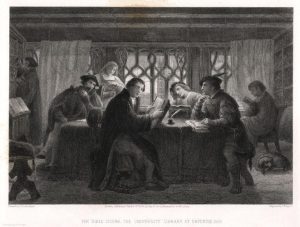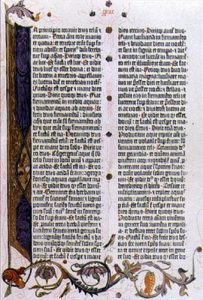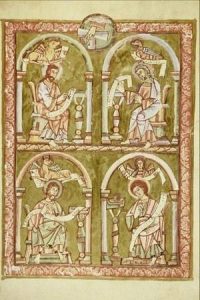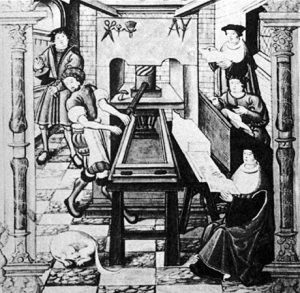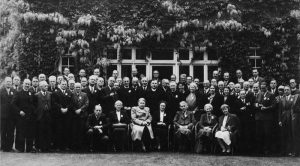The Reformers and the Bible
Luther was an Augustine monk ; in obedience to his order he studied for many years and was then appointed Professor of the Holy Scriptures at Wittenberg University. It may come as a surprise to us today, but the Bible was widely read and studied within the Catholic Church. Luther discovered texts which formed the basis of the Reformation principle “sola gratia” (by grace alone), while studying and making notes on Paul’s epistles : man’s salvation comes by God’s grace alone and does not in any way depend on his works (which was not the teaching of the Roman Catholic Church).This was the basis of Luther’s disagreement with traditional doctrine, and it was taken up by all the other Reformers. According to Luther, Scripture could only be read in the light of “sola gratia” which opened the reader’s mind and led to “sola scriptura”.
As for Ulrich Zwingli, the Reformer in Zurich, he gave prime importance to the way in which Scripture was read : what was the right interpretation, how could one understand it correctly ? He and all the other Reformers considered “sola scriptura” to be the very basis of the Reform Movement.
What do these two Latin words mean, which can be translated by “by scripture alone” ? “Scripture” refers to the Bible, the essential reference for Christian faith. It was not the Bible that was new to the Reformers, but the novelty lay in the fact that it was the Bible “alone” which was important.
The Church no longer interpreted the Scripture
In the 4th century Saint Augustine wrote that the Bible was the supreme guide. However, he added that the Church taught the exact meaning of the Scripture and it’s correct interpretation. In the 16th century, Cajetan, the Pope’s representative who opposed Luther, declared that any interpretation had to take into account former commentaries and reflect Church doctrine.
What did Luther reply ? He said that Scripture should only be interpreted according to “the conscience, bound by the Word of God”. Luther broke away from the Church saying that the Bible was not necessarily linked to traditional interpretation. Everyone recognised the sovereign authority of the Bible, but Luther contested its traditional inextricable association with its interpretation by the Church : this is one of the meanings of “Sola scriptura”, that the Bible should not be interpreted by the clergy. In the 16th century the interpretation of the bible had become controversial, critical of the church institution. The way in which Protestants read the Bible led to the reforming of the Church.
There was a return to the literal sense of the Bible without any allegorical interpretation
The Reformers rejected allegorical exegesis which was popular at the end of the Middle Ages. For example, the word Jerusalem, allegorically, meant the Church and not the town in Judaea, its literal meaning. It could also stand for the individual or the Kingdom of God. According to the sense given to a particular word, the meaning of the Biblical text could vary considerably. Some allegorical symbolism was very far-removed from the text. The Reformer Zwingli was the first to question the real meaning of the Biblical text. He was influenced by the Humanists in his support of scientific exegesis and the quest for the true, literal meaning of the Scriptures. The principle of “sola scriptura” taught that the historical or literal sense of the text was important, without the allegorical interpretation which many Reformers considered to be dishonest intellectually.
The contribution of printing : the Bible became more accessible
The invention of printing was of considerable importance. It made reading the Bible a real possibility for all. Gutenberg’s first printed book was a Bible in Latin. Compared to a hand-written manuscript, a printed book was produced more quickly and at a much lower cost. This enabled a much greater distribution of the Bible, even if it was largely restricted to the educated and the well-to-do. The only access to the Bible for people in the Middle Ages was through the liturgy of the Latin mass, sermons, sculptures and paintings in churches or the mystery plays, which took place in front of cathedrals at Christmas and Easter. That is to say, the Bible was always interpreted by the clergy or depicted by artists. Once the Bible was printed, people who could read had direct access to the text itself, without the confusion of different interpretations. This was truly a revolution.
The contribution of traditional exegesis
“Sola scriptura” was often understood to mean that only the Bible could be considered important, without the traditional Church exegesis. But in fact, the Reformers did not intend to do away with this tradition nor the centuries of reflection and meditation on the Scripture. Indeed, they knew the works of the Church Fathers well and did not hesitate to quote them, especially Saint Augustine, to support their arguments. For the Reformers, traditional interpretation of the Scriptures was a useful addition but did not have the same authority as the Bible itself.
“Sola scriptura” did not mean that the Bible was the one and only book worth knowing, but it did have definitive authority. However, it was also necessary to be guided by a sermon in order to interpret it correctly.
The contribution of Humanism : tools for a better translation of the Bible
The Humanists considered the ancient Greek and Roman texts from a scientific and critical angle. They sought to establish the best “source text“, that is to say the most reliable text in the original language, after having compared several manuscripts. In order to do so, one had to have a good knowledge of the classics. This expert knowledge was also used for studying the Bible.
Most Reformers had been instructed by Humanists and used their methods. They insisted on a scholarly approach and intellectual integrity for interpreting the Bible in a sermon. Calvin called for the use of dictionaries, grammar books, the commentaries which already existed and he also advocated that texts should be studied in their original language. He urged people to read the Scriptures using their faith and their intellect.
Calvin thought that the Bible could only be understood when placed in context ; the Holy Spirit inspired the authors, but was constrained by human knowledge at the time. So it was important that the Bible reader should be aware of the background and the age in which these texts were written.
According to 16th century Humanists, critical study of the texts in no way prevented clarity in interpretation. It did not necessitate the use of secrecy or mystery as was the case for allegorical or mystical texts. The Humanist scholar built up his arguments in a way that was understandable to all. Preachers had to be able to explain, prove and convince. As they shared their expert knowledge with the people, the study of theology became available to everyone and was no longer restricted to the clergy.
What’s more, as the Reformers and the Humanists encouraged the reading of the Bible in one’s own language, the Scriptures became much more widely accessible.

